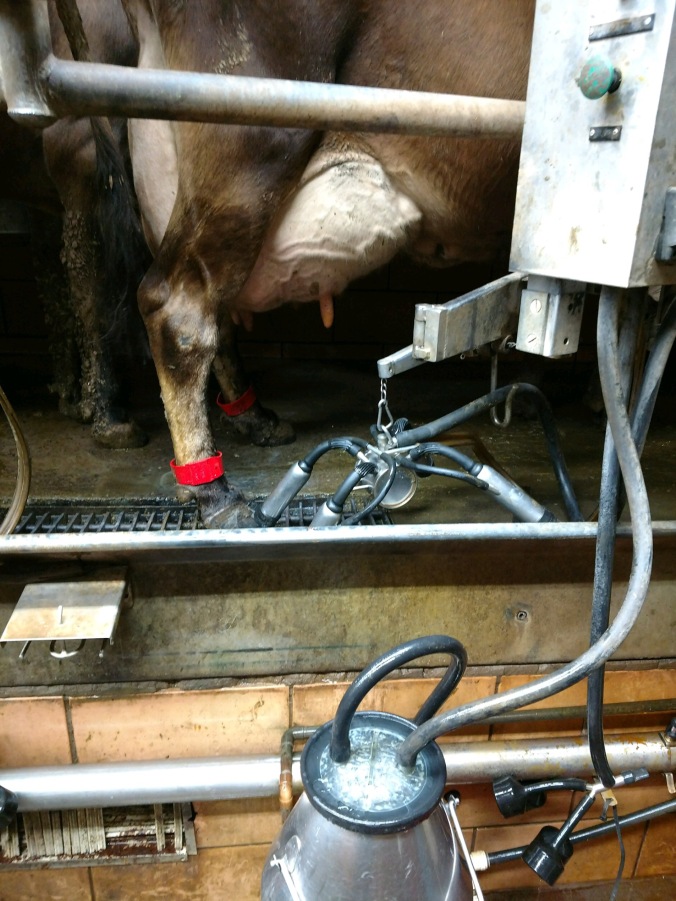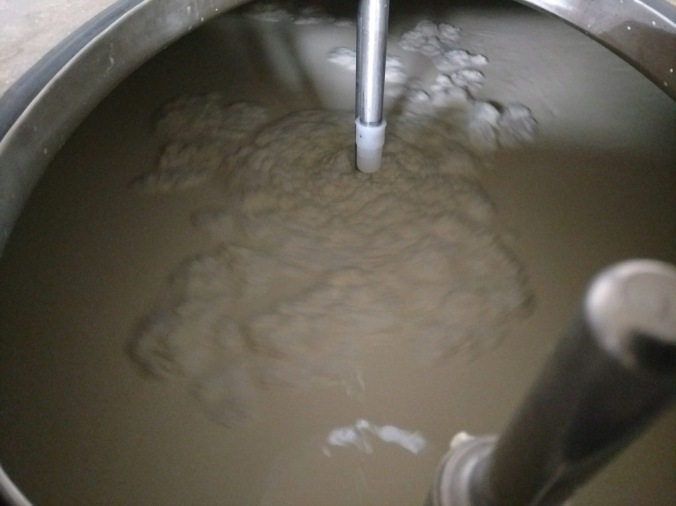Hey everyone! I can’t believe it’s almost Thanksgiving! These last few weeks have certainly flown by! We’ve been busy on the farm getting ready for winter, we’ve only had a dusting of snow so far. I thought it was pretty neat to play in! With the holidays approaching I thought this would be a good time to talk about my favorite subject-milk.
There’s so many different kinds of “milk”out there nowadays and a lot of unfounded fear in the good wholesome product my herdmates make. There’s a lot of reasons people may give for not drinking milk like “we are the only species who drinks another animals milk”. But my farmer mom tells me the cat, dogs, chickens and pig all love their cows milk!! Some other people may say that cows are treated unkindly or spend all day long getting milked. Our farmers treat us girls with the utmost respect, making sure we have the best feed and all we want of it, and that we are comfortable, happy and healthy. If any of those things is missing from the equation, we won’t give the quality or quantity milk that is our potential. My farm mom says cows actually have it really easy because they only are getting milked 2-3 times a day for about 10 minutes at a time. She said that is nothing compared to a baby cluster feeding or going through a growth spurt!! She said she could sit there for hours with the baby nursing!! Bet she wishes she was a cow sometimes!
The milk you buy from the store is fresh. Let’s take our milk for example. Our truck driver comes to pick up our milk every day. That means every day that milk is going to the plant. Some larger farms even have trucks pickup a couple times a day! That mean that milk is getting from cow to you in a matter of days. Not too bad. Also, the only ingredients in milk are milk and vitamins. That’s especially to make sure your little kiddos drinking the yummy stuff get all the nutrients they need right there. Whole fat cows milk is recommended for growing kiddos because the fat and protein are crucial for brain development, as well as all that calcium, and with the added vitamins, they are all set to be the super heroes they are destined for!
So what is it that people don’t like about milk? If cows are treated great and it’s the healthiest choice out there, what gives? Well I’m not to sure exactly. I know us babies definitely love it!

Maybe it’s the hormones? There are naturally occurring hormones in milk, but as you can see in the chart below (taken from Igrow.org) the amount of hormones in milk is pretty insignificant compared to other foods you eat.

What about supplementing with rBST? There is absolutely no evidence that this has any affect on your milk or you, there is no difference in milk with it or without. But because we live in a society where the consumer is always right, and the populous decided they did not want dairy supplemented with rBST, most co-ops have told their farmers they have to stop using it. Like I said, it is completely safe but people didn’t want it used so it’s not. Contrary to some recent “documentaries” there is no evidence that rBST or the naturally occurring hormones cause early puberty or cancer or any other disease. We’ll talk more about this at a later date but if someone is using scare tactics to make you believe something (especially without evidence!) it’s probably not true. I could easily say that there are no studies proving that drinking milk won’t give you pink polkadots, but that doesn’t mean it does! It’s all in the wording. So if you’re worried about hormones in milk, I wouldn’t worry at all.
So what else is there that people would worry about? Ah yes…antibiotics. Let’s talk about this. Sometimes us cows get sick. Although our farmers do everything they can to keep us healthy, sometimes it just happens. Let’s say one of the girls gets mastitis. My farm mom has had it a couple times and she said it was worse than labor. Pretty painful stuff we’re talking about. But with some antibiotics in her system and some rest, she said she was good to go and back on her feet pretty quickly. So what happens if a cow gets mastitis? Well, they are generally treated with antibiotics that are administered into the quarter (cows have 4 teats so each one is called a quarter) that is infected. In almost all places that cow gets plastic red leg bands and she is put in a different section of that barn. In some places it could be a few stalls that are separate or in our case, it’s an open part of that barn right off that parlor with straw to lay on in a pack setting, instead of stalls. These areas are called sick pens or hospital cows. This would be for cows that are treated with antibiotics, any cows that have had a calf in the past few days or maybe someone who isn’t quite sick but isn’t quite right and just needs some extra attention. These sick pens are generally located right next to the milking parlor for a few reasons. One is the cows won’t have far to go to get milked.If you don’t feel good you don’t want to go to work so we keep them close. Also they are by the parlor because that’s a busy place, with people walking by all the time. This way the cows are being looked at all day long. The pack that houses the cows getting ready to calve is generally near there too.
Okay so now what? A cow is sick, she gets leg bands to identify her as treated, she is moved to a different pen, and all of that is recorded, either in a computer program or in my farmers handy dandy notebook. When that cow comes in to get milked, her milk goes right into a bucket, so it has no contact with the untreated or “good” milk. Here’s an example:

You can see the bright red leg bands (pretty hard to miss right?) and the bucket hooked up to catch her milk. Her milk will continue to go into that bucket until not only is she done getting antibiotics but past that, until all residue has cleared from her milk. Farmers have this nifty little tool that they use to test to make sure the milk has no residue in it, and once that happens and she’s feeling better, the leg bands come off and she goes back to live with her buddies in the barn.
But can there ever be antibiotics in your milk? I mean what happens if she loses her leg band? What happens if the bucket milker doesn’t get hooked up? What if that milk goes into the tank?
At every single farm, on every single load across the US, every time a milk truck driver comes to pick up the milk he takes a sample of the tank. Every. Single. Time. Every. Single. Farm. When he gets to the plant, he may only have one farms milk on his truck or he may have several. Before he unloads any milk, a sample is run from his tanker. If that sample is negative for antibiotics, he is allowed to proceed into the plant and unload the milk. If it comes back positive, he has to leave and get rid of the milk and thoroughly wash his truck before picking up milk again. Then all the samples of milk from that truck are run to see who has the “bad” milk. If it is you, you will be held responsible for all the milk on that truck. Most co-ops also have a rule about how many times this can happen before you’re not allowed to ship milk anymore. So no milk that has antibiotics is ever even allowed near the plant, let alone your glass.
So you see that there is never a chance of antibiotics in your milk. I hope that this talk we had cleared up any questions you may have had. I would hate to think with the holidays coming (or really any day I guess!) that you would be missing out on all good things dairy out of fear of what was going in your mouth. So fear not and gobble down the whip cream on the pie, slather on the extra butter on your biscuit and get that extra cheese pizza to watch the game with on Sunday. And then wash it all down with a glass of milk and know your body is thanking you for all that dairy goodness.

Happy Thanksgiving everyone! Oh yea, don’t forget to like my Facebook page and follow along on my journey! Until next time,
Mut